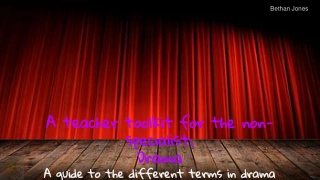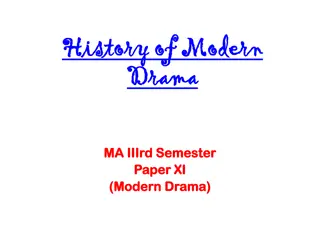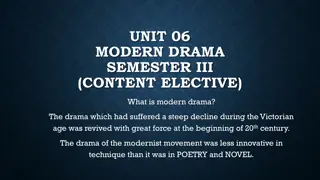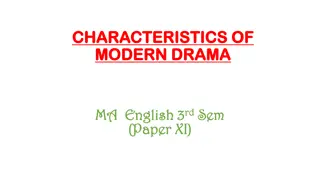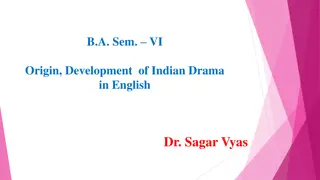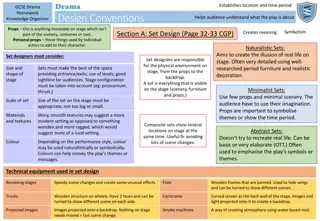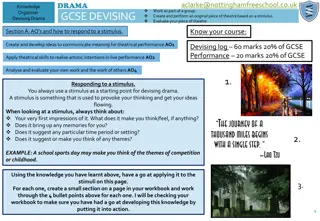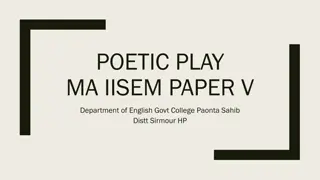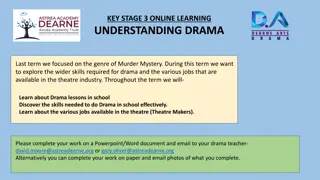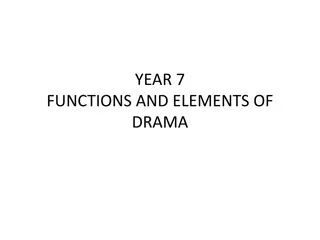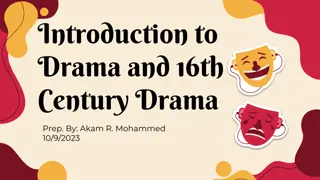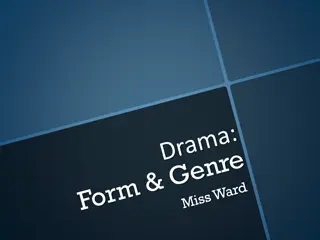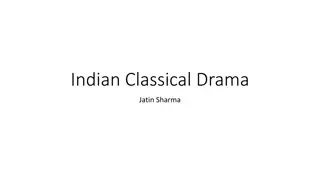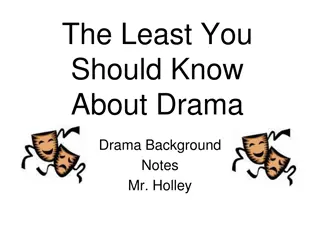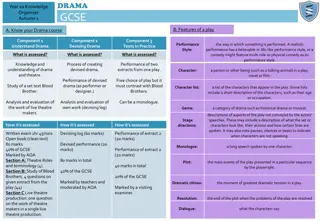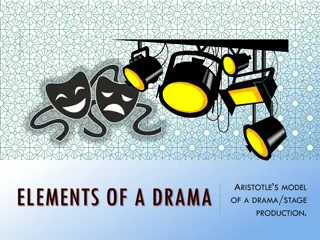Insight into Drama: Its Elements and Impact
Drama, a form of art designed for live performances on stage, relies on dialogue and action to engage the audience. Through actors, facial expressions, gestures, and soliloquies, drama conveys emotions and complexities. The stage setting creates a captivating experience, commanding the audience's attention. However, drama has limitations in portraying certain elements compared to prose fiction. Despite this, its concise nature allows for deep exploration of central themes in a single performance.
Download Presentation

Please find below an Image/Link to download the presentation.
The content on the website is provided AS IS for your information and personal use only. It may not be sold, licensed, or shared on other websites without obtaining consent from the author.If you encounter any issues during the download, it is possible that the publisher has removed the file from their server.
You are allowed to download the files provided on this website for personal or commercial use, subject to the condition that they are used lawfully. All files are the property of their respective owners.
The content on the website is provided AS IS for your information and personal use only. It may not be sold, licensed, or shared on other websites without obtaining consent from the author.
E N D
Presentation Transcript
What is Drama Drama or play is designed to be performed on a stage by live actors. It consists of dialog together with the direction of action. Drama does not rely on narration, however, presents you with speech and action. Drama, like prose fiction, utilizes plot and characters, develops a theme, arouses emotion or appeals to humor, and may be escapist or interpretive in its dealings with life. Like poetry, it may draw upon all the resources of language, including verse
How Drama presents its action Through actors On a stage Before the audience
Through actors its impact is direct. Instead of responding to words or printed page, spectators see what is done and hear what is said. The audience can feel strong emotion through facial expression, gesture and speech rhythm and intonation. Entry to the character mind can be made through soliloquy and aside. In Soliloquy, a character is presented as speaking to himself- that is he made to think aloud. In aside, a character turns from the person with whom he is conversing to speak directly to, or for the benefit of, the audience, thus letting the audience know what he is really thinking or feeling.
On the stage Because a play presents its action on the stage, it can forcefully command the spectator s attention. The stage is lighted; the theater is dark; extraneous noises are shut out; the spectator is almost literally pinned to his seat; there is nowhere he can go; there is nothing else to look at; there is nothing to distract. The playwright has extraordinary means by which to command the undivided attention of the audience. Unlike the fiction writer or the poet, the playwright is not dependent on the power of words alone.
Before an audience Reading a short story or novel is private transaction between the reader and a book, but the performance of play is public. The spectator s response is affected by the presence of other spectators. For ex. A comedy become funnier when hears others laughing, a tragedy more moving when others are present to carry the current of feeling.
The limitation of drama Drama cannot easily elaborate the unspoken thoughts or reflections. Drama cannot present complex actions that involve non- human creatures such as wild horses or charging bull. Drama find it more difficult to shift the scene rapidly than writers of prose do. They usually stick to one setting for an extended period of time. They cannot easily present adventures at sea or action on a ski slope. Prose fiction is placed on a well-defined plot, exposition, strong conflict, dramatic confrontations. On the other hand, play is very brief, it is written so that its central meanings may be grasped in a single performance.
Type of Drama Aristotle divided all drama into tragedy and comedy. Tragedy recounts the fall of an individual; its begins in prosperity and ends in adversity. Comedy describes the regeneration or reformation of a group of a society; it begins with the adversity and resolves in prosperity
Type of drama Pure form of tragedy and comedy have rarely been written since the classical period; most British and American plays offer some mixture of the two forms. For ex. Shakespeare s tragedies include witty and humorous scenes, and his comedies often deal with serious and threatening problems. in most plays written before the twentieth century, one pattern or the other predominates. When the pattern and emotion are truly mixed, the play is called tragic comedy, a term first used by John Fletcher in 1611. For him the term means tragedy with a happy ending. It is the dominant form of the twentieth-century drama.
Other form of drama Farce : it is a form of comedy crammed full of humorous actions and dialogue; shift in action are usually very rapid. Ex. Chekhov s the Bear Melodrama: it is a debased of tragedy with happy ending. The adversities in melodrama all grow out of plot rather than character. Ex. The mortgage is due, the family business is falling. The hero always arrives just in time to pay the mortgage, save business and rescue the heroine. Social drama: it sometimes called problem plays, evolved in the nineteenth century and dominated the stage through the early part of the twentieth century. It explore social problems and individual s place in society. Ex. Susan Glaspell s Trifles, Miller s Death of Salesman.
Other form of drama Full-length plays are drama that usually contain either three to five separate act. Ex. Hamlet or long story of discreet scene, ex. The glass Menagerie One act play are rarely subdivided


